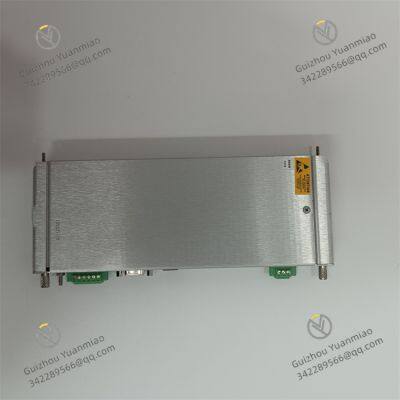Product Description
I. Overview
Bently 135031-01 is an eddy current displacement sensor assembly (including a probe, extension cable, and preamplifier). Based on the principle of "non-contact measurement", it collects key parameters of rotating machinery rotors in real time, such as radial/axial displacement and vibration amplitude. With a measurement accuracy reaching the micrometer level, it can capture tiny positional changes of the rotor during operation (e.g., 0.1μm-level vibration). Its core advantages lie in "no wear due to non-contact measurement, stable operation over a wide temperature range, and resistance to oil pollution and dust interference", making it particularly suitable for industrial rotating equipment scenarios with high rotational speeds (supporting a maximum of 60,000 r/min), high temperatures (operating temperature: -50℃~200℃), and heavy oil pollution.
Bently 135031-01 monitors the radial vibration of the rotor. When the rotor has an eccentric vibration of 0.5mm due to blade fouling, the sensor captures and transmits data to the monitoring system in real time, providing an early warning of the "rotor unbalance" fault 12 days in advance. Maintenance personnel perform dynamic balance correction to prevent the vibration from increasing to 1.2mm (shutdown threshold), avoiding a single unit shutdown loss of over 800,000 yuan. In the propylene compressor of a catalytic cracking unit in a petrochemical plant, the sensor monitors the axial displacement of the bearing. When the axial displacement increases from 0.3mm to 0.8mm due to bearing wear, an alarm is triggered 8 days in advance, preventing compressor shutdown caused by bearing seizure (a single shutdown loss of over 3 million yuan). In the blast furnace blower motor of an iron and steel plant, the 135031-01 operates stably in an environment with alternating high and low temperatures (-30℃~180℃) and high dust levels, with a Mean Time Between Failures (MTBF) of ≥250,000 hours, meeting the high reliability requirements of the motor for 24-hour continuous oxygen supply to the blast furnace.
Bently 135031-01 adopts a "three-component integrated design":
Probe: Features a stainless steel housing (with strong corrosion resistance). Common probe diameters are 5mm/8mm/11mm (to adapt to different measurement gap requirements), and the measurement range is 0.2~2.0mm (adjustable according to the probe model). Non-contact measurement avoids wear to the rotor.
Extension Cable: Made of oil-resistant and high/low temperature-resistant fluororubber insulation material. The length can be selected as 3m/5m/10m (to adapt to the equipment installation distance). The cable shielding layer adopts a double-layer copper mesh + aluminum foil structure, providing strong anti-electromagnetic interference capability.
Preamplifier: Uses an industrial-grade reinforced housing and has built-in signal amplification and filtering circuits. It converts the weak eddy current signal collected by the probe into a standard voltage signal (e.g., -4V~+4V, corresponding to 0~2mm displacement) and supports seamless connection with the Bently 3500 monitoring system and GE Mark VIe control system. Meanwhile, the preamplifier is equipped with functions of "probe open/short circuit diagnosis and cable impedance matching" to ensure the reliability of signal transmission.

II. Technical Parameters
1. Measurement Performance Parameters
2. Environmental Adaptability Parameters
3. Electrical and Connection Parameters

III. Functional Characteristics
1. Non-Contact High-Precision Measurement, No Wear and Long Service Life
Bently 135031-01 adopts the eddy current effect non-contact measurement technology. There is no physical contact between the probe and the rotating rotor, which fundamentally avoids the wear problem of traditional contact sensors (e.g., piezoelectric acceleration sensors) caused by friction, significantly extending the sensor's service life (average service life ≥5 years, 2-3 times that of contact sensors). In an aero-engine test bench, the sensor continuously monitors rotor vibration for 8,000 hours without performance degradation. In the main fan of a coal mine, the non-contact design prevents dust from wearing the measurement components, allowing the sensor to operate continuously for 3 years without maintenance.
At the same time, its micrometer-level measurement accuracy (resolution: 0.1μm) can capture tiny vibration abnormalities of the rotor. In the dynamic balance test of a steam turbine rotor, the 135031-01 can distinguish a vibration difference of 0.2μm, helping maintenance personnel accurately judge the effect of dynamic balance correction. In the misalignment monitoring of a compressor shafting, the sensor captures an axial displacement deviation of 0.3mm, providing an early warning of the "shafting misalignment" fault and preventing bearing damage due to overload.
2. Wide Temperature Range and Strong Anti-Interference, Adapting to Harsh Working Conditions
Aiming at the harsh working conditions of "high temperature, oil pollution, dust, and strong electromagnetic interference" of industrial rotating equipment, the 135031-01 achieves stable operation through a reinforced hardware design:
High-Temperature Resistance: The probe uses high-temperature-resistant ceramic insulation material and a stainless steel housing, enabling long-term operation in the bearing box of a gas turbine at 200℃. The high-temperature model (customized) can even withstand the turbine-end environment at 350℃.
Oil and Dust Resistance: The probe has an IP67 protection rating, and the extension cable is made of fluororubber material with oil resistance. In the residue hydrotreating compressor of an oil refinery, the sensor is immersed in a lubricating oil mist environment for a long time without signal drift.
Strong Electromagnetic Protection: With a double-layer shielded cable and EMC design of the preamplifier, the signal-to-noise ratio of the vibration signal collected by the sensor is ≥70dB beside the rolling mill motor of an iron and steel plant (with 10kV high-voltage frequency converters nearby), without false fluctuations.

3. Early Fault Warning, Reducing Shutdown Risks
As the "front-end sensor" for rotating machinery monitoring, the high-precision data of Bently 135031-01 is the core foundation for early equipment fault warning. By linking with the Bently 3500 monitoring system or GE Proficy Machinery Health Manager platform, the following functions can be realized:
Trend Analysis and Warning: Based on the historical vibration data collected by the sensor, a trend curve is generated. When the vibration amplitude slowly increases from the "normal range (e.g., ≤0.3mm)" to the "warning range (0.3~0.8mm)", the system triggers an audible and visual alarm. For example, the bearing wear fault of a propylene compressor in a petrochemical plant is warned 8 days in advance through trend analysis.
Fault Characteristic Identification: Combined with vibration spectrum analysis, the sensor data can assist in identifying fault types, such as "increased 1x frequency vibration → rotor unbalance", "increased 2x frequency vibration → shafting misalignment", and "increased high-frequency vibration → bearing raceway wear". In the steam turbine generator set of a power plant, the "rotor unbalance" fault is accurately located through the data of 135031-01, preventing the fault from expanding.
Interlock Protection Linkage: When the vibration exceeds the "shutdown threshold (e.g., 1.2mm)", the sensor data triggers the emergency shutdown interlock of the equipment. In an overspeed vibration scenario of a gas turbine, after the 135031-01 captures a vibration of 1.5mm, it links with the shutdown system within 0.5 seconds to avoid rotor overspeed accidents.
4. Flexible Adaptation and Convenient Operation & Maintenance
The 135031-01 has high flexibility in installation, configuration, and maintenance, reducing the difficulty of on-site industrial application:
Multi-Specification Adaptation: The probe diameter (5mm/8mm/11mm) and extension cable length (3m/5m/10m) can be selected according to the equipment installation space and measurement requirements. For example, small-diameter probes are suitable for installation in narrow bearing boxes, and long cables are suitable for monitoring the motor rotor at a long distance (e.g., 10m).
Calibration-Free Design: The preamplifier has a built-in "automatic gain calibration" function, requiring no manual calibration after installation. Only the "measurement gap (e.g., 0.8mm)" needs to be confirmed. In the installation of a blast furnace blower in an iron and steel plant, maintenance personnel complete the sensor installation and commissioning within 30 minutes.
Visual Fault Diagnosis: The preamplifier displays the working status through LED indicators (steady green → normal, flashing red → probe open/short circuit). Maintenance personnel can quickly judge sensor faults without connecting software. During the inspection of a chemical plant, the "extension cable breakage" fault is located within 5 minutes, greatly shortening the troubleshooting time.


Honeywell 51307198-276 Digital Output Module
Honeywell CC-PUIO01 24-Point Universal Input/Output (I/O) Module
Honeywell 51454205-175 Universal I/O Module
ABB 3BHE023784R1023 Controller Module
GE IC8008SI228RD2-EE Safety Input Module
GE IS220PDIAH1A Discrete Contact Input Terminal Board
GE DS200DCFBG2BNC MRP420024 Power Supply Board
Bently 330130-040-01-CN 3300 XL Extension Cable
Bently 330104-05-11-10-02-CN Proximity Transducer Systems
Bently 330103-00-12-10-02-CN Proximity Transducer Systems
Bently 330104-11-22-10-02-CN Proximity Transducer Systems
Bently 330130-045-02-05 Extension Cable
 yezi
Hi there! Welcome to my shop. Let me know if you have any questions.
yezi
Hi there! Welcome to my shop. Let me know if you have any questions.





